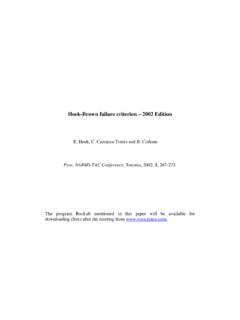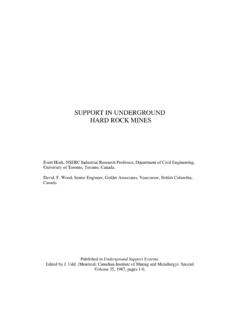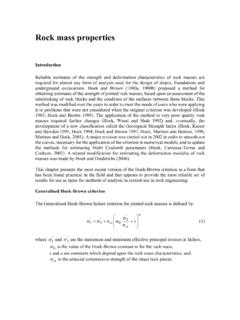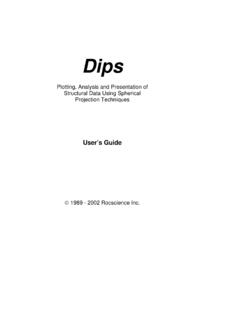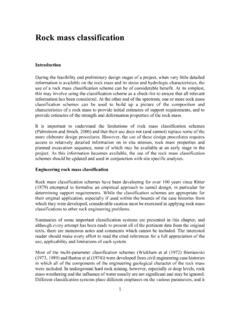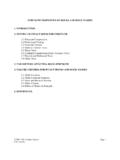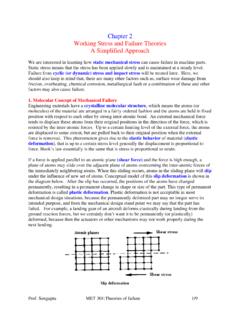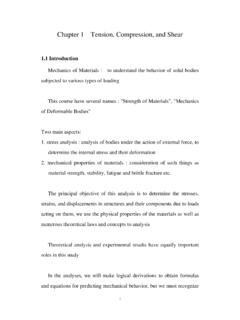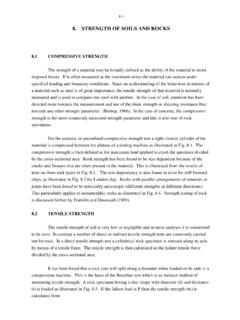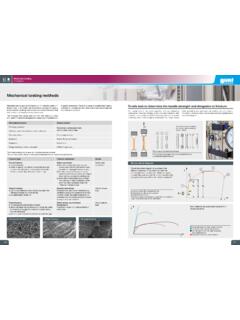Transcription of Rock Mechanics - an introduction for the practical engineer
1 Rock Mechanics - an introduction for the practical engineerParts I, II and IIIF irst published inMining MagazineApril, June and July 1966 Evert HoekThis paper is the text of three lectures delivered by the author at the Imperial College ofScience and Technology, London in November 1965 as part of the University ofLondon series of Special University Lectures in Mining and Mechanics2 Rock Mechanics - an introduction for the practical engineerE. Hoek, , (Eng.), (Eng.).Senior Chief Research Officer, Rock Mechanics Division, National Mechanical Engineering Research Institute, South African Council for Scientific and Industrial Research, Pretoria, Republic of South AfricaPart 1.
2 Theoretical ConsiderationsIn this, the first of three articles containing extracts from a series of six lectures deliveredat the Royal School of Mines, Imperial College of Science and Technology in November1965, the author covers theoretical considerations. The other two will deal withlaboratory techniques and then with rock Mechanics in the purpose of this series of articles is to present some of the principles of rockmechanics to the reader who is interested in knowing something about the subject withouthaving to become too involved in technical details.
3 The content of the articles is based,almost entirely, upon the author's own experience and, hence, does not represent acomplete review of the whole subject of rock Mechanics . Consequently, the formulationof an overall rock Mechanics philosophy has been assiduously avoided and the reader isleft to draw his own conclusions from the facts as they are and ScopeIn 1963 the Rock Mechanics Committee of the American National Academy of Scienceadopted the following definition1:Rock Mechanics is the theoretical and applied science of the mechanical behaviour ofrock.
4 It is that branch of Mechanics concerned with the response of rock to the forcefields of its physical is convenient to subdivide rock Mechanics into the following branches:a)Structural rock Mechanics , which is concerned with the stability of engineeringstructures in which the material is predominantly )Comminution, which is concerned with the reduction of rock to small fragments bythe application of external forces as in drilling, blasting, cutting and these branches of rock Mechanics involve the control of rock deformation andfracture processes.
5 In the first case, excessive rock failure (in this context, failure is takento mean either excessive deformation or fracture) must be avoided in order to preservethe stability of the structure and, in the second case, rock fracture must be induced withthe minimum input of external energy. Major disasters, such as the Malpasset andRock Mechanics3 Vajoint dam failures, and the Coalbrook mine disaster, serve to illustrate the importanceof rock fracture in practical engineering Fracture - Griffith TheoryRock Mechanics research in South Africa was initiated some 15 years ago in an effort toprovide an understanding of the rockburst hazard which occurs in many deep-level effects of a typical rockburst are illustrated in Figure 1.
6 It has been defined2 asdamage to underground workings caused by the uncontrolled disruption of rockassociated with a violent release of energy additional to that derived from falling rockfragments. The main causes of rockbursts are associated with the energy changesinduced by mining in the rocks surrounding large excavations and these causes have beenreviewed the rock Mechanics point of view, the main characteristic of a rockburst is the factthat it occurs in hard, brittle, highly competent rocks .
7 Consequently, in studying thefracture behaviour of these rocks , it was considered justifiable to study the behaviour ofthe rock material itself, treating it as a homogeneous, isotropic solid and ignoring theeffect of major geological discontinuities. The deficiency of this approach, when appliedto the fractured and geologically discontinuous rocks which occur on or near the earth'ssurface will be immediately obvious to the reader. Nevertheless, it is believed that anunderstanding of the basic mechanism of the fracture of rock material can be ofassistance in formulating a rational behaviour pattern for rock 's theory of brittle fracture3, modified by McClintock and Walsh4 to allow for thepredominantly compressive stresses in rock Mechanics , has been found to provide areliable theoretical basis for the prediction of rock fracture phenomena5.
8 This theory isbased upon the assumption that fracture initiates at inherent cracks and discontinuitieswithin the material and that propagation of these cracks occurs as a result of the tensilestress which is induced at the crack tip under load. Brace6 has shown that fracture in hardrock usually initiates in grain boundaries which can be regarded as the inherentdiscontinuities required by the Griffith 's original theory was concerned with brittle fracture under conditions of appliedtensile stress and he based his calculations upon the assumption that the inherent crack,from which fracture initiates, could be treated as an elliptical opening.
9 When applied torock Mechanics , in which the applied stresses are predominantly compressive, thissimplifying assumption is no longer valid and the theory has to be modified to accountfor the frictional forces which occur when the crack faces are forced into contact. Thismodification was carried out by McClintock and Walsh4 who made further simplifyingassumptions concerning the mechanism of crack closure. These simplifying assumptionshave recently been theoretically validated by extent to which the modified Griffith theory defines the fracture behaviour of rock isRock Mechanics4illustrated in Figure 2.
10 Published triaxial strength test data for the fifty rock and concretetypes listed in Table 1 are included in this graph. In order to render the test resultscomparable and to minimise differences caused by different testing techniques, specimensizes and environmental conditions, the values are plotted on dimensionless scales whichare obtained by dividing each test result by the uniaxial compressive strength of thatparticular further illustration of the usefulness of the Griffith theory in defining the fracturebehaviour of hard rock is given in Figure 3.
